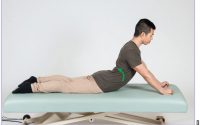Touching the Lived Body in Patients with Medically Unexplained Symptoms
Medically unexplained symptoms (MUS) are estimated to be the presenting problem for 35% up to 64% of new patients in general practice. The term MUS has received a lot of criticism, yet, recent diagnostic ‘improvements’ still fail to offer a better understand its cause and provide better therapy. However there is an increasing amount of research that shows the importance of personal history, attachment, and trauma which can be a key element in understanding MUS. In a new article, published in, the authors reflected on how hands-on bodywork influences Body Awareness, helps patients to mentalize and express what they experience which can be seen as a more body integrated psychotherapeutic approach of MUS.
One case of MUS is called alexithymia, the absence of mental elaboration of bodily arousal, such as chronic fatigue syndrome, fibromyalgia, non-cardiac chest pain, irritable bowel syndrome, and to some extent panic attacks as well as medical and psychiatric disorders. Alexithymia can be seen as the lack of ability to explore and express one’s own bodily sensations and feelings, as well as the emotional presence. This inability influences the embodied being and participating of these patients in the world, which is coined as ‘the lived body’ and underlies what is mostly referred to as body awareness (BA).
The group of researchers from Belgium explores an innovative hypothesis how hands-on bodywork can influence body awareness and serve as a rationale for a body integrated psychotherapeutic approach of MUS. Research not only shows that BA is a bottom-up ‘bodily’ affair but is anchored in a interoceptive-insular pathway (IIP) which in turn is deeply connected with autonomic and emotional brain areas as well as verbal and non-verbal memory. Moreover, it is emphasized how skin and myofascial tissues should be seen as an interoceptive generator, if approached in the proper manual way.
The article offers supportive evidence explaining why a ‘haptic’ touch activates this IIP, restores the myofascial armored body, helps patients rebalancing their window of tolerance and facilitates BA by contacting their bodily inner-world. Finally, the article reflects on how the integration of bodywork with non-directive verbal guidance can be deeply healing and resourcing for the lived body experience in MUS.
The full article (which often can be not easily digested) can be read here


